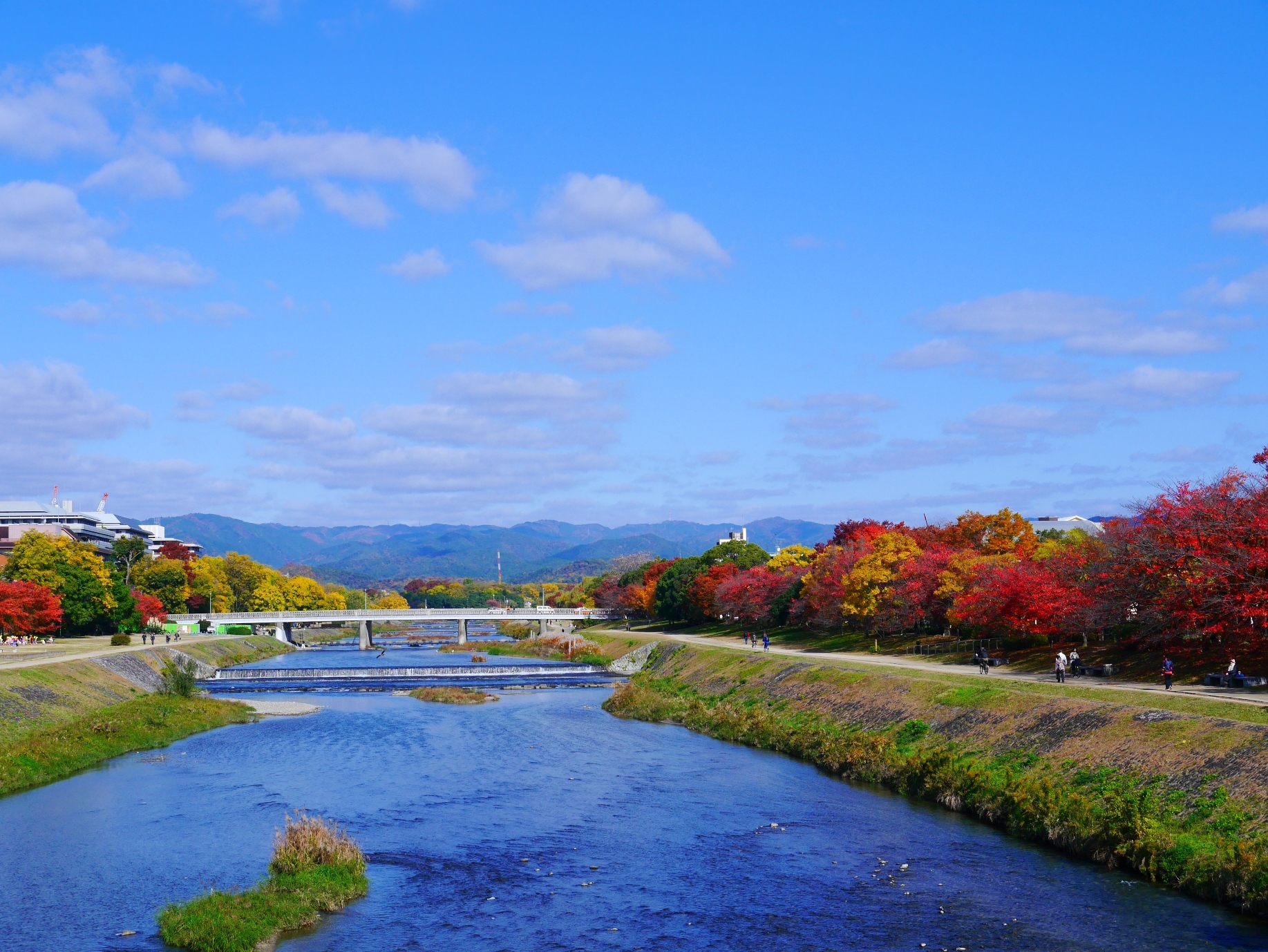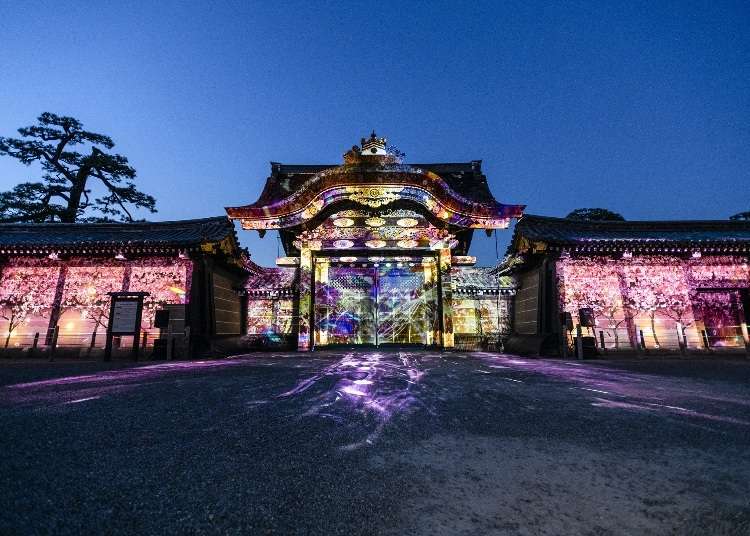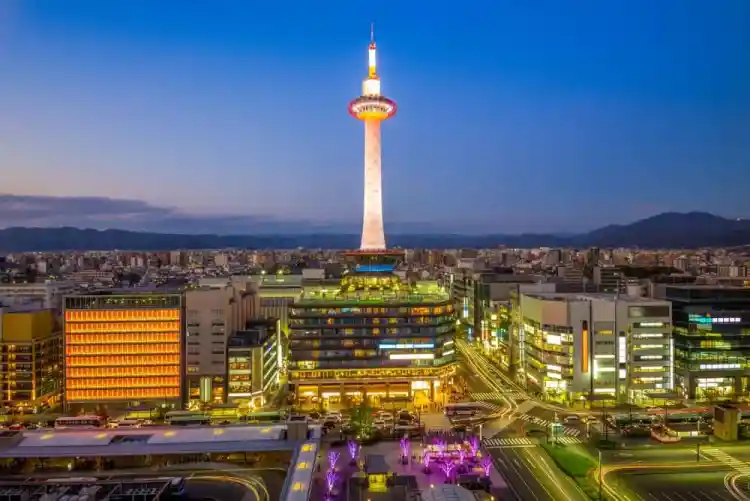When the moon hangs hazily over Higashiyama and the night takes over the streets of Gion, Japan’s warmed-over wanted turns into the dream of every romanticist. For hundreds of years, the eyeful of Kyoto’s night scenery has been worshiped in poetry and literature and praised in folk songs such as the Gion Kouta a Japanese verse from the 1930s.
With its lantern-lit narrow street alleys, tranquil temple complexes and seasonal light-ups, there are myriad ways to have a marvellous time in Kyoto at night. Alimony on reading to find out well-nigh the weightier places in Kyoto to see without dark.
Activities in Kyoto After Night

Here is how to spend a night out in Kyoto.
1. Walk the Streets of Gion at night
An wool must-see when visiting Kyoto is the famous Gion district at night which is known for its geisha culture, tea houses and historic buildings. In recent years, Kyoto’s municipality has been devoted to preserving the city’s traditional recreate through variegated policies.
The maximum height of new buildings is restricted. Most constructions are fairly small. Newly opened stores in historic areas often have to tousle in with the facades of the surrounding old buildings, and numerous alleyways are paved with stone tiles instead of asphalt.
These are just some of the regulations that indulge visitors to still get a taste of the “Old Kyoto” – expressly during a night stroll. Gion’s narrow street alleys ornate by dozens of traditional wooden buildings squint oddly romantic when all the red lanterns light up the district at night.
Rules for Visiting Gion at Night
While Gion naturally attracts myriad visitors with its warmed-over beauty, it’s important to keep some vital rules in mind upon visiting as inappropriate behaviour has unfortunately increased in recent years.
Most importantly, taking photos of private roads and inward private property is forbidden. Some streets plane have signs set up to ban visitors from taking pictures. Visitors should moreover refrain from stopping geisha or maiko (a geisha in training) in the middle of the street and taking pictures of them without permission.
The municipality deemed it necessary to sieve these mannerisms to maintain the eyeful of Gion and preserve the local culture.
2. Leave a Prayer at Yasaka Shrine
When visiting the Gion district at night, don’t forget to stop by Yasaka Shrine. At night, Yasaka Shrine’s vermilion red main gate is beautifully illuminated. The shrine itself is accessible all night long, making it a unconfined wing to a stroll without dark.
It’s moreover one of the most popular spots for hatsumōde (初詣) in Kyoto, the first shrine visit of the New Year in Japan. On the night of New Year’s Eve, the zone is packed with people who wish for good fortune in the coming year.
3. Attend the Yoiyama Festivities Surpassing Gion Matsuri
Every year in July, Yasaka Shrine hosts the Gion Matsuri, Kyoto’s most important yearly festival. While the main event culminates in a procession during the day on July 17th, the three nights leading up to it are just as enchanting. These nights are known as Yoiyoiyoiyama, Yoiyoiyama and Yoiyama.
During the Yoiyoiyama (July 15th) and Yoiyama (July 16th), the streets of Shijō and Karasuma are reserved for pedestrians only, giving visitors the rare opportunity to freely explore the zone without the usual traffic.
The huge floats that are stuff carried through Kyoto on the day of the main procession are lit up with lanterns and can be worshiped on the streets during the night festivities. Additionally, numerous supplies stalls selling everything from sugar-coated fruits to yakisoba well-constructed that perfect nightly festival ambience.
4. Spend the Evening on the Banks of the Kamo River

Meandering through the heart of Japan’s warmed-over capital, the Kamo River is an atmospheric place to spend a convivial evening.
Along the river tropical to Gion-Shijō Station, there are many restaurants with terraces facing the waterside promenade that are platonic for having dinner on warm, rainless evenings.
Tons of people enjoy the night by sitting on the grass withal the riverbanks, listening to the street musicians and having a yack with friends.
5. Enjoy Nightlife on Pontocho Alley and Kiyamachi Street
At first glance, a dazzling nightlife might not be among the list of things associated with Kyoto. Most people would stay in Osaka instead of Kyoto if they’re looking for the weightier nightlife. However, there are two districts to trammels out when looking for bars and nightclubs in Kyoto.
Pontocho Alley is Kyoto’s hot spot for bar hopping. Running withal the west side of Kamo-River tropical to Kyoto-Kawaramachi and Gion-Shijō Station, this district has a huge selection of izakaya, restaurants and regular pubs to segregate from. Most buildings are built with a traditional wooden exterior facade, preserving the warmed-over recreate of this street.
For nightclubs, Kiyamachi Street is the right choice. Just alimony pursuit Pontocho Alley up north to reach this area. Since both districts lie proximal to each other, they are easy to combine on a night out in Kyoto.
Are you visiting any other cities in Japan in the evening? Don’t forget to read our guides to the best things to do at night in Osaka and Tokyo!
6. Go for a Night Walk Virtually Kiyomizu-Dera and Yasaka Street
Higashiyama must be one of the most mystical areas in Kyoto to visit without nightfall. Stuff home not only to Gion but Kyoto’s most famous temple Kiyomizu-dera and the scenic Yasaka Street, this won’t come as a huge surprise.
Kiyomizu-dera was built in 778 and officially supposed a UNESCO World Heritage Site in 1944. The temple itself is wieldy until virtually 6 PM, with extended opening hours three times a year during special night illuminations (last wangle at 9 PM). All relevant information well-nigh the light-ups can be found on their official website.
While Kiyomizu-dera is expressly worth visiting at night during the special illumination events for the cherry blossoms and storing leaves, walking up the hill to the archway of the temple makes for a unconfined view of Kyoto at night. And since the temple is facing the west of the city, it’s moreover a trappy place for seeing the sunset!
Another spot worth checking out at sunset is Yasaka Street. Just like Gion, this zone is made up of many traditional wooden buildings that are warmly illuminated by lantern lights during the night.
The centre of this district is marked by the famous Yasaka Pagoda that towers whilom the streets of Higashiyama. Lit up at night, it’s a view to not miss out on when visiting Kyoto at night.
7. See Nijō Castle Lit up at Night

Built in 1603 as a residence for Tokugawa Ieyasu, Nijō Castle is a significant relic of warmed-over Kyoto. It was officially designated a UNESCO World Heritage Site in 1994. While the castle normally closes at 5 PM (last entry at 4 PM), there are multiple occasions throughout the year to see it entirely lit up at night.
“NAKED Flowers” is a digital art exhibition that can be experienced in Nijō Castle for virtually a month during variegated seasons. In the past, this included colourful projections on the wooden main gate, variegated illuminated installations inside the castle, and a light-up of the trees in the surrounding garden.
Usually, these special light-up events unshut their doors to visitors during the cherry floweret (March–April) and storing foliage (October–November) season. In 2023, a summer exhibition was held between July and August. It’s weightier to trammels if there is an ongoing light-up event in Nijō Castle upon travelling to Kyoto. The visit is veritably worth it!
8. Pass Through the Gates of Fushimi Inari Shrine at Night
Fushimi Inari Shrine is one of the few sights in Kyoto that is wieldy 24 hours a day. During the morning and afternoon, the crowds flock to this famous place to see the “thousand vermilion red gates” lined up the way up to the top and lanugo to the foot of Mt. Inari. You’ll have a much increasingly peaceful wits when visiting in the early morning or late evening hours.
The main towers and areas at the foot of the mountain are beautifully lit up without dark. If you decide to walk up Mt. Inari at night, make sure to bring proper equipment such as hiking boots, mosquito spray during the hot season, and flashlights.
A special illumination happens during the two-day-long Motomiya Festival in July. The night surpassing the Motomiya Festival (known as Yoimiya Festival), hundreds of red paper lanterns light up Fushimi Inari Shrine and the vermilion gate path up to Mt. Inari. The event is accompanied by festive taiko pulsate performances.
9. Enjoy the Night View from Kyoto Tower and Kyoto Station
Kyoto Tower has one of the best night views of the municipality to offer. Measuring 131 meters in height, it’s the tallest towers in Kyoto – a unshared landmark in a sea of otherwise small buildings. The 3rd floor of the observation deck features a Sky Lounge that is unshut until 11 PM.
Kyoto Station is located right next to Kyoto Tower. It has an admission-free observation deck on the uppermost floor and the “Sky Tunnel” from which you have a unconfined view of the municipality at night, too.
10. Walk up the Lantern-Lit Pathway to Kifune Shrine
Kifune Shrine lies subconscious in the very north of Kyoto and is defended to the Japanese deity of water. Plane though it takes some time to wangle this area, it’s definitely worth visiting. What draws people to this place is not only the shrine itself, but the lantern-lit staircase leading up to it.
Known as a popular destination on hot summer days and zappy storing evenings, Kifune Shrine is one of the dreamiest places to visit during Kyoto’s coldest months.
When there’s a lot of snowfall in January and February, and the red lanterns uplifting the way up to the shrine are covered with white caps, the shrine holds a special night illumination event until 8 PM.
11. Have a Romantic Stroll Through Arashiyama Kimono Forest
Arashiyama Kimono Forest is a permanent illumination in Kyoto. This originative installation is located right next to Arashiyama Station and makes for a mythological photo spot, both during the day and the night.
The “forest” is made up of over 600 pillar lanterns that are coated with kimono fabric on the inside. Every pole is two metres upper and showcases a colourful pattern, creating the illusion of walking through a mystical grove.
12. Stay at a Traditional Ryokan
Ryokan are traditional Japanese inns that can be found anywhere wideness the country. These accommodations are usually equipped with hot springs and rooms with tatami mats.
And with its many picturesque spots and historic buildings, Kyoto is an platonic destination to stay at one of these overnight.
You can either opt for a increasingly secluded zone in the mountains surrounding Kyoto like Arashiyama or stay closer to the municipality centre if that’s what you finger increasingly well-appointed with.
If you familiarise yourself with some vital rules surpassing your stay, booking a night or two in a traditional Japanese inn veritably holds the potential to level up your Kyoto experience..
13. Wits a Kabuki Performance at Minamiza Theatre
As one of the three traditional performing arts of Japan, experiencing a Kabuki performance in Kyoto is a unconfined way to swoop deeper into the local culture.
Kabuki ripened during the early Edo Period (1603–1868) when a miko (shrine maiden) named Okuni began giving performances in the dry riverbed of the Kamo River.
Women were sooner vetoed from performing Kabuki on stage in the 17th century and men started playing both the sexuality and male characters. The male actors specialising in playing women are known as onnagata (女形) (literally meaning “female role”).
Minamiza Theatre in Kyoto plays shows multiple times a week with matinee and evening performances. Ticket prices range between 5.000 Yen and 16.000 Yen, depending on the seat category. The plays are usually virtually four hours long, meaning that the evening shows start in the (late) afternoon and end sometime virtually 8 PM.
Tickets can be booked through Shochiku. Some of the shows plane have English guidance available.
14. Learn Well-nigh Kyoto’s Unique Geisha Culture

Kyoto is known to be the heart of geisha culture in Japan. Geisha have mastered various Japanese arts such as traditional dance, classical instruments, and flower arrangement, and are highly skilled in conversation and hospitality. Dinners with a geisha are therefore a very plush experience.
Some cultural wits providers offer a wide range of events to meet geisha and maiko in Kyoto. This includes the supra dinner evenings, tea ceremonies, as well as music and flit performances in Kyoto’s theatres – all unconfined additions to your Kyoto itinerary.
When looking for this kind of wits upon travelling to Kyoto, alimony in mind that geisha and maiko are not the same. A maiko is an workmen geisha, meaning she is still working on perfecting her skills.
15. Visit Eikandō Temple in Autumn
When visiting Japan during the cherry floweret or storing foliage season, seeing the special illuminations is one of the weightier things to do in Kyoto at night. As for seasonal light-up events during autumn, Eikandō Temple is one of the most stunning places to revere Kyoto’s zesty red leaves at night.
The illumination of the temple garden surrounding the Hojo Pond takes place every year between early November and early December until 9 PM with the last ticket half an hour surpassing the official closure.
16. Watch a Yosakoi Performance at Night
Yosakoi is a Japanese festival flit rooted in Awa Odori. It originated in Kōchi Prefecture on Japan’s smallest main island Shikoku in the 1950s. Ever since then, this highly energetic and creative flit style has slowly but steadily taken Japan by storm.
Even though there are some worldwide elements and a set of rules, every team has a fairly unique style. Many of them transpiration costumes while dancing, some tell stories through their choreographies or use tools like fans, parasols, or flags to enhance their performance.
Bigger festivals are often splintered wideness variegated venues in the same city. And Kyoto is no exception. Yosakoi festivals are weightier experienced throughout the whole day, but the stages at night come with a special atmosphere.
In Kyoto, you can see many talented teams perform during the Kyoto Sakura Yosakoi (early April) and the Ryoma Yosakoi (mid-November). Both festivals take place over a whole weekend, which amounts to two full days of performances.
The Kyoto Sakura Yosakoi features a total of virtually 100 teams. The main stage is located in front of the Heian Shrine, where you can moreover watch the winning performances in the evening (yes, there’s a races included):
The Ryoma Yosakoi is centred virtually university teams. You can see the night performances until 8 PM at the venue right in front of the main towers of Kyoto Station.
17. See the Daimonji Festival
Among the things to do in Kyoto at night, the Daimonji Festival is one of the best-known seasonal events to wits in summer. It takes place each year on August 16th during the week of Obon a Buddhist festival to commemorate one’s deceased ancestors.
Starting from 8 PM, five huge bonfires are stuff ignited one by one in the mountains enclosing Kyoto. The most famous and first one to be lit up is the shaped fire (a kanji weft meaning “large”).
A popular viewing spot for seeing the first fire is the banks of the Kamo River virtually Marutamachi. Some hotels in the municipality centre of Kyoto host special night viewing events on their rooftops, from where you can see all five fires urgent in the mountains.
Conclusion – Exploring Kyoto at Night
As the warmed-over capital, Kyoto is one of Japan’s most atmospheric and wistfully trappy destinations without sunset.
Everyone who is looking for scenic night walks, cultural experiences or immersive illumination events will most likely love Kyoto at night. For people who are rather in search of dazzling nightlife with bars and nightclubs, Tokyo and Osaka might be the largest choice.
While many places in the municipality are worth visiting at night all year round, keeping an eye on the seasonal event calendars will help you make your trip to Kyoto plane increasingly memorable.
